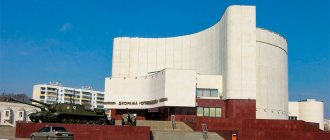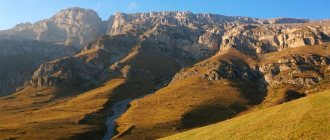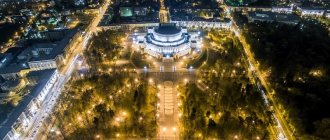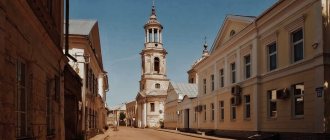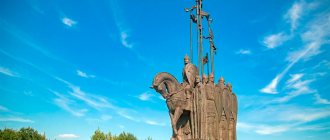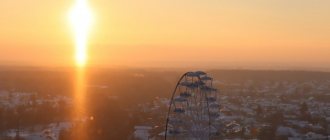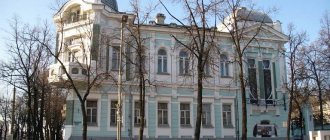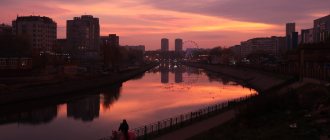The Belgorod region is one of the youngest regions of the Russian Federation. It was established within its current administrative-territorial boundaries on January 6, 1954. At the same time, the Belgorod region is an ancient region that has a rich historical past. This is evidenced by the fact that the regional center, the city of Belgorod, celebrated its 1000th anniversary several years ago.
At the turn of the XVI - XVII centuries. To reliably protect Russian possessions, a continuous line of military fortifications was built - the Belgorod defensive line, which stretches for almost 800 kilometers. Belgorod became a military-administrative center, in which the Great Belgorod Regiment was stationed.
Belgorod is a city with long historical traditions. But it often happened that, while fulfilling its historical purpose as an outpost of the southern state borders, it lost the most visual evidence of its own history - archives, architecture, indigenous population.
The Great Patriotic War left its indelible mark on the souls of people and on the appearance of the city. Belgorod was literally wiped off the face of the earth; after its liberation, less than 200 residents returned to the city.
Now our White City has been rebuilt, people from all over the world live and work in it. A very important task is to preserve for future generations everything that speaks eloquently about its glorious history. We invite you to walk with us through some of the historical places of our White City
== Smolensky Cathedral, Belgorod == 50°35.69′ N.
w. 36°35.691′E e. Expression error: unrecognized punctuation character "," , Expression error: unrecognized punctuation character "," &spn=0.3,0.3&t=k&hl=ru (G)
History of Belgorod.
There are discussions among historians about the exact time of the emergence of the city of Belgorod. Some believe that in ancient times there stood the Seversky settlement, founded in the 10th century by order of Prince Vladimir and which served to protect the borders of Rus' from nomadic peoples. Therefore, in 1995, the 1000th anniversary of the White City was solemnly celebrated. But most archaeological finds confirm another hypothesis, according to which Belgorod arose much later - in 1596, when the fortress was built. This means that the city is a little over 400 years old.
With the loss of its significance as a defensive structure, Belgorod turned into a county town. After a big fire occurred in the 18th century, it had to be rebuilt. St. Petersburg architect Alexey Kvasov brilliantly coped with the task, introducing into the appearance of the city features characteristic of the rectangular layout of the capital. Today Belgorod is a bright and spacious city, which gets its name from the color of the mountain on the slope of which it stands. Numerous buildings and houses built from almost white stone reinforce Belgorod's trueness to its name.
Lenin Park
The Central Park of Culture and Recreation was opened in 1956. Hundreds of different trees and ornamental shrubs were planted here, a gorgeous “Round Dance” fountain was installed, and a children’s playground was installed. The main alley of the park is decorated with a plaster monument to Vladimir Ilyich Lenin. In 2001, a major reconstruction was carried out. Paving slabs were laid in the park, an electrical substation was erected, the most modern attractions at that time were equipped, and an electrical network was laid. An amusement park, a rope town, and a small petting zoo appeared here. After the walk, you can have a snack in one of the cafes located on the territory or grab food from stalls offering snacks and drinks.
Nowadays all kinds of city events, folk festivals and holidays are held here. Popular bands and bands often perform on the park's summer stage. This is a great place to spend leisure time for all age groups; everyone can find something to their liking.
Assumption-Nicholas Cathedral.
Almost all buildings and sights of Belgorod dating back to the early historical period of the city were destroyed during the Civil and Great Patriotic Wars. Despite this, there are countless museums, temples, sculptures and places to relax in the city. The oldest monuments that Belgorod is proud of are its temples. Erected in 1703, the Assumption-Nicholas Cathedral was empty or used for other purposes for a long time after the 1917 revolution. After its return to the possession of the Orthodox Church in 1998, a large-scale restoration of this landmark of Belgorod began, which lasted seven years. Currently, the temple belongs to the Marfo-Mariinsky monastery.
Krapivenskoe settlement
Those who are interested in ancient history will be interested in the Krapivensky settlement. This is a whole complex of archaeological monuments , which is located near the village of Krapivnoye on the banks of the Koren River, which was navigable a thousand years ago. Scythian tribes once lived here, but then they were forced out by the northerners - one of the Slavic tribes that created Kievan Rus.
The settlement is a multi-layered archaeological site; its lower layers date back to the 5th century BC. e., that is, directly to the Scythian period. But archaeologists also found artifacts dating back to the northerners and ancient Russian culture, that is, people lived here for a thousand years or even more.
All found jewelry, tools, and weapons can be viewed in the local local history museum. And it’s worth taking a walk around the site for the very atmosphere of such an ancient place. Scientists believe that there was a fairly large city of Busara here, but there is no mention of it in Russian chronicles.
Smolensky Cathedral.
The Smolensk Cathedral, erected in honor of the sign originating from the icon of the Blessed Virgin Mary in 1703, is an architectural and historical monument in the Moscow Baroque style, as well as one of the most interesting sights of Belgorod. The battles that raged here during the Great Patriotic War left many “scars” on the Smolensk Cathedral. In 1980, after restoration, an organ hall was opened in its premises. In 1991, the cathedral was handed over to believers, and from that moment on, services have been held there. The dominant place in the temple is occupied by “Hodegetria” - the icon of the Smolensk Mother of God.
Bohdan Khmelnitsky Oak
This is a natural monument of its own, and at the same time it can be considered a historical landmark. Dendrologists estimate that the oak was planted more than 300 years ago. Legend claims that he was landed by Prince Gregory Romodanovsky and Ukrainian Hetman Bohdan Khmelnytsky to commemorate the reunification of the two countries. Today, this relict spreading tree still symbolizes the unity of the two Slavic peoples.
This oak is located on the territory of the village of Dubovoe, near the temple of the icon of the Mother of God “Control of the Loaves”. It is popular with newlyweds, who arrange photo sessions here and hang locks on a chain entwined around a mighty oak tree (its trunk diameter is more than 5 meters). The relict tree is protected by the state.
However, this is not the only long-liver in the region. Between the villages of Yablochkovo and Dmitrievka, in the Shebekinsky district, there grows a unique Pansky oak, whose age is 550 years old, according to dendrologists. They say that Peter the Great himself stayed here when returning from the Battle of Poltava. The height of the tree is 35 m, and the girth of the trunk exceeds 5 m.
Cathedrals of Belgorod.
There are a lot of attractions in the city of Belgorod, among them a sufficient number of new cathedrals built in the last decade: the Church of the Pochaev Icon of the Mother of God, the Archangel Gabriel, the Blessed Matrona of Moscow, the Great Martyr George the Victorious and the Temple of the Holy Martyrs Faith, Hope, Love and their mother Sophia.
Belgorod State Museum of History and Local Lore.
In any city there is a museum telling about the history of its origin and development. There is such a museum in Belgorod. It was founded in 1924. During the Nazi occupation, almost all funds were destroyed or taken away. After the end of the war, it resumed its work, and in 1964 it acquired the status of a museum of regional significance. Every year, the museum's exhibitions are viewed by more than 80,000 visitors.
Fountain Patron
Fountains are, of course, an exquisite decoration of the city and an integral part of its landscape. One of the main city fountains is considered to be the “Patron”, installed on the square near the main building of Belgorod State University.
In 2005, this unique fountain was installed according to the design of A. Shishkov. The composition of the hydraulic structure is crowned with a sculpture of the Archangel Gabriel. It is quite natural that Archangel Gabriel was chosen as the spiritual benefactor and protector of the university. After all, it was he who taught the book, arithmetic and all the wisdom of Moses, told him about the creation of the world, about the flood, about the location of the celestial planets.
The four-meter figure of the holy messenger Gabriel, holding a ball in the palm of his outstretched hand, is washed by numerous streams of water, sparkling in the sun with all the colors of the rainbow. The jets are illuminated, and the ball emits a glow even when the fountain is turned off. This hydraulic structure is very popular among those who want to take a photo against the backdrop of the fountain and have a great rest. Many consider the fountain one of the beautiful places in Belgorod for memorable selfies and relaxation.
Belgorod State Literary Museum.
The Literary Museum, another attraction of the city of Belgorod, is quite young, it was opened in the spring of 1999, but it is already loved by guests and residents of the city. The exhibits on display are located in a house that belonged to the merchant Selivanov. The building, built in the 18th century, is itself an architectural monument. Visitors are introduced to the interior decoration of the merchant's house, as well as the life that existed in those days. In addition, the guides talk about the development of literature in the region, and also introduce letters, manuscripts and archives of Russian and modern writers. The Literary Museum often hosts literary readings and presentations of newly published books.
Prokhorovskoe field and monastery
It is worth going to the Prokhorovskoe Field Museum-Reserve, whose territory covers several thousand hectares. These are two districts of the region at once - Prokhorovsky and Yakovlevsky, and it is best to travel here by car. The command post of General Rotmistrov has been preserved here, and museums have also been organized in the villages of Yakovlevo and Prokhorovka. It is worth visiting the Church of the Apostles Peter and Paul. On the walls of the building you can read thousands of names of soldiers who died in the great battle.
The Holy Trinity Kholkovsky Cave Monastery is located in the Chernyansky district, about 120 km from Belgorod, near the village of Ezdotskoye. The monastery was carved out of a chalk mountain about 400 years ago, but under Catherine the Great it was abolished and restored only in 1999. Archaeologists have found ancient monastic cells and an underground temple, where services are still held today. Although, of course, the modern monastery is located on the surface of the earth.
Belgorod State Art Museum.
The exhibition of the Belgorod Art Museum includes more than 4 thousand exhibits, represented by paintings, icons, graphics and sculptures. In addition, as a result of collaboration with other museums, temporary exhibitions are organized where you can see exhibitions of the Russian, Tula or Kharkov museums. In the salon, located on the first floor of the Art Museum, you can buy some modern work of art as a souvenir.
Museum Square
In the city center on the left bank of the Vezelka there is a beautiful museum square, surrounded on three sides by spectacular architectural sights and green spaces of Victory Park. It got its name due to the concentration of museums in one place. A large-scale diorama museum, an art gallery and a local history museum in an interesting building with decor in the form of balconies-towers.
The center of the square is decorated with a large mosaic fountain with multi-colored lighting in the evening, nicknamed “Salute” by local residents. There is a dance floor and a small stage where local musicians hold concerts on weekends and holidays. This square is also loved by photographers; there are many beautiful places for photo shoots in Belgorod. Flower beds, neat lawns, picturesque alleys among park trees - a piece of paradise in the center of a bustling metropolis.
State Museum of Folk Culture.
The museum of folk culture displays objects that belonged to representatives of the Scythian tribes, as well as the ancient Slavs and nomads who lived on these lands in the 8th-10th centuries. The exhibition dedicated to the history of the peasantry in Rus' is of great interest. It includes a collection of towels, traditional clothing, belts, carpets and other household items.
Sundial
The sundial on Narodny Boulevard invariably attracts great interest among Belgorod guests. They have become a real city symbol. The composition of bronze and granite with a diameter of 11 meters was created by the famous city sculptor Kostenko.
Sundial
While working on the chronometer, he relied on medieval illustrations of clocks that used to be installed in city squares. In sunny weather, the time on such a watch can be determined with an accuracy of 10 minutes. With the onset of dusk, an LED display lights up on them, simulating the starry sky.
- Address: st. 50th anniversary of the Belgorod region.
- Cost of visiting: free.
- Opening hours: 24 hours a day.
Monument to the Holy Equal-to-the-Apostles Prince Vladimir - the Baptist of Rus'.
One of the symbols of Belgorod is the monument to Grand Duke Vladimir, towering on the top of the Kharkov Mountain. The monument to the Baptist of Rus' was unveiled on the eve of the celebration of the 2000th anniversary of this event. At the foot of the 22-meter sculpture there is an observation deck from which you can admire magnificent views of the city.
Fountain "Nika"
Every year Belgorod is growing, and with it the number of fountains is increasing, of which there are more than 15. They are all working. They all differ from each other in their design. One of them is the Nika fountain on Olympic Square. Nearby is a sports complex named after the famous Russian athlete Svetlana Khorkina. The figure of the ancient goddess Nike, towering in the center of the fountain, is very impressive. In her hands raised above her head she holds a laurel branch. And around the statue, murmuring streams of water rush upward.
This whole complex is harmoniously combined and symbolizes victory in sports. In hot weather, a fountain is valuable not only because it represents a significant element of the architectural composition, but also because it refreshes the air and gives life-saving coolness. This square with a fountain is a very beautiful place in Belgorod. It is popular not only among local residents, but also among numerous visitors to the city.
